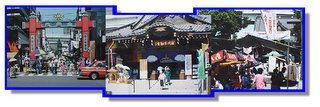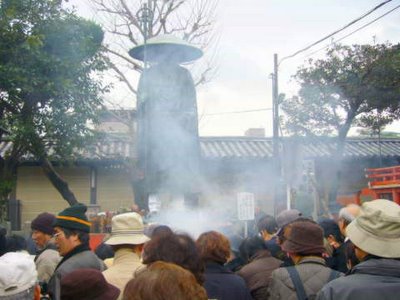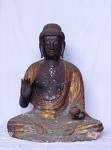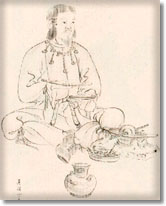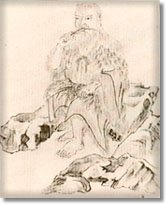:::::::::::::::::::::::::::::::::::::::::::::::::::::::::::::::::::::::::::::::::::::::::::::::::::::
Meguro Fudo Temple 目黒不動
〔天台宗 泰叡山 瀧泉寺〕(目黒区・東京) Meguro Fudoo
Ryuusenji 瀧泉寺 Ryusen-Ji
One of the five great Fudo Temples in the Kanto area.
関東三十六不動霊場
. 36 Fudo Pilgrim Temples - Nr. 18 .

http://ginjo.fc2web.com/36gyokei/gyokei.htm
The most famous Fudoo Temple in the Kanto Area is the one in Meguro, where even today on the 28th of each month, the day dedicated to Fudoo, there is a huge festival and bazaar in the temple grounds where I always went to check out Daruma dolls and antiques.
If you visit there, do not forget to walk around the main temple hall to the little forest in the back. There is someone waiting for you worth meeting. I will not spoil your fun by telling!
On the 28th there are also great fire rituals (goma kuyoo 護摩供養) at different hours during the day, where you can get your talismans and other belongings consecrated by Holy Fire. I once bought one talisman with the number of our car for Traffic Safety and the priest would not hand it over until it had passed the Holy Smoke. Since that day, we never had an accident with that car.
The temple compounds are quite big, with a lot of other buildings and statues to look at. One of my favorite is a stone grotto with En-no-Gyooja, the Founder of the Mountain Priests (yamabushi).
I strongly recommend you visit Meguro Fudoo on any 28th day of a month, it brings back memories of OLD EDO which you have never known. Have a look at Meguro ablution waterfall in the compounds.
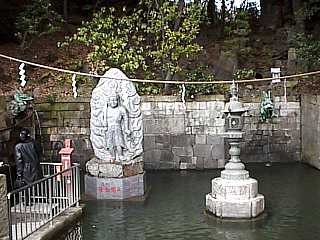
円仁 Priest Ennin had a dream when Fudo Myo-O told him to produce a spring with fresh water for the village, so he hit the ground with his Tokko 独鈷 Vajra and clear water came forth.
Even in the hottest summer this spring does not dry out.

source : 4travel.jp/travelogue
瀧泉寺 水かけ不動明王 Mizukake Fudo to throw water at
. tokko 独鈷 と伝説 Legends about the Vajra Thunderbolt .
:::::::::::::::::::::::::::::::::::::::::::::::::::::::::::::::::::::::::::::::::::::::::::::::::::::::::::::::::::::::::::
- quote
Meguro Fudō-dō 目黒不動堂 Meguro Fudo Hall
The Meguro Fudō-dō was known as 泰叡山滝泉寺 Taieizan-ryūsen-ji Temple.
It was affiliated with the Tendai sect and located in 東叡山 Mount Tōei.
It was opened by the Tendai priest 慈覚大師 Jikaku Daishi.
The principle image of the temple is Fudō Myo-o.
Practitioners of asceticism would carry out cold-water ablutions
in the 独鈷の滝 "Tokko-no-Taki" waterfall situated in the temple grounds.
It is considered that from the mid-Edo period onwards,
many people flocked to the temple to seek spiritual benefit
and stores and houses gradually began to form.
. source - Tokyo Metropolitan Museum .
:::::::::::::::::::::::::::::::::::::::::::::::::::::::::::::::::::::::::::::::::::::::::::::::::::::::::::::::::::::::::::
. Legends about 不動明王 Fudo Myo-O in Edo .
When priest Ennin was young he stayed at a hermitage with his master, Priest Koochi 広智 Kochi.
That night Kochi had a dream where Fudo Myo-O appeared to him. When he told this to Ennin in the morning, Ennin said he had just the same dream that night. So they found a sacred tree and cut a statue of Fudo as he had revealed himself to them and venerated it there.
Later when Ennin came back from China, he visited Kanto again and stayed at Meguro. That night again he had a vision of Fudo in his dream.
Fudo Myo-O told him to produce a spring with fresh water for the village, so he hit the ground with his tokko 独鈷 Vajra and clear water came forth.
At the shrine Ōtori-jinja 大鳥神社 Otori Jinja in Meguro, Yamato Takeru is venerated as a deity.
In the left hand he holds a hinawa 火縄, rope to make fire, in the right hand the sword Kusanagi no Tsurugi 草薙の剣.
This is said to be the features of Fudo Myo-o, made by Ennin.
. Yamato Takeru, Yamatotakeru 日本武尊 .
prince of the Yamato dynasty.
. Ōtori-jinja 目黒大鳥神社 Otori Jinja Meguro .
.......................................................................

- source : facebook
:::::::::::::::::::::::::::::::::::::::::::::::::::::::::::::::::::::::::::::::::::::::::::::::::::::::::::::::::::::::::::
『境内は台地の突端にあり、水が湧き老樹が茂り、独鈷(とっこ)の滝や庭の池が美しく、庶民の信仰といこいの場所でした。
目黒不動は台地の高台に作られていて、本堂は一番高いところに位置しますが、それに連続して林があり、その中に露座の大日如来坐像が祀られています。目黒区指定有形文化財に指定されていて次のように説明しています。(昭和59年3月31日 指定)
『この像は宝髪、頭部、体躯、両腕、膝等十数か所に分けて鋳造し、それを寄せて一体とした吹きよせの技法で造られている。体躯にくらべ頭部を大きく造るのは大仏像共通の特色で、面相も体躯も衣文表現もよく整っている。
また、台座の連弁に開眼の年、入仏開眼供養の際の導師や僧俗の歴名等を記し、製作年代は天和三年(1638)、江戸に住む鋳物師横山半右衛門尉正重作等の刻名があることも貴重である。』
Meguro Fudo 目黒不動尊より
http://meguroku-net.com/meisyo/megurofudou/FudouTop.htm
Statue of Dainichi Nyorai in the back yard behind the temple

http://meguroku-net.com/meisyo/megurofudou/P3-nyorai/F3-nyoraizou.htm
:::::::::::::::::::::::::::::::::::::::::::::::::::::::::::::::::::::::::::::::::::::::::::::::::::::
Hiroshige, 100 Views from Edo
25. The Original Mt. Fuji in Meguro

100 Views from Edo, all prints by Hiroshige
:::::::::::::::::::::::::::::::::::::::::::::::::::::::::::::::::::::::::::::::::::::::::::::::::::::
More from the Daruma Museum
Fudo in Five Colors 五色不動尊
Osame-Fudo、the last Fudo ceremony of the year 収め不動
by Gabi Greve
En no Gyoja 役行者、E no Ozunu 小角
En no Gyooja and Shugendo … An Essay
:::::::::::::::::::::::::::::::::::::::::::::::::::::::::::::::::::::::::::::::::::::::::::::::::::::
While in Meguro, do not forget to visit the Temple with the 500 Arhats.
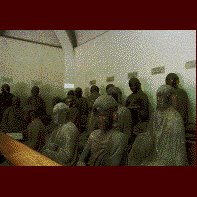
http://www41.tok2.com/home/kanihei5/gohyakurakanji.html
Meguro Temple Rakan-Ji 目黒の羅漢寺
and other Rakan temples
:::::::::::::::::::::::::::::::::::::::::::::::::::::::::::::::::::::::::::::::::::::::::::::::::::::
On the way is also a temple dedicated to Yakushi Nyorai, deity of healing.
Here he is named
TA KO Yakushi 多幸薬師
Yakushi of Great Happiness
TA - much, a lot
KO - happiness, good luck
TAKO 蛸 is also the name of an octopus, so this pun of the sound is put on an ema votive tablet, where the octopus is bringing a lot of money and good luck to the people.

. Ema 絵馬 Votive Tablets Prayer Boards .
Joojuu in 成就院(たこ薬師)Temple Joju-In
When the priest Ennin was on his way home from China to Japan, his ship was caught in a big storm. So he offered one of the statues, Yakushi Nyoria, to the God of the Sea and prayed for help. Thus the sea became calm and he reached the shores of Japan. Later the statue was found on the shore, carried by an octopus, to bring it back to its owner.
. Ennin 円仁 .
(794 - 864) - Jigaku Daishi 慈覚大師 / 慈覺大師
. Yakushi Nyorai, the Buddha of Medicine 薬師如来 .
.................................................................................
Tako Yakushi 蛸薬師

the triad of Yakushi Buddha
with a seated Yakushi and the Bosatsu of Sun and Moon by his side
日光菩薩、月光菩薩
The statue is shown only once a year, on January 8, the sacred day dedicated to this deity.
The healing power for cancer and atopy of the skin is especially famous.

The amulet of the "rubbing stone" o nadeishi おなで石御守り
"If you believe strong enough, your ailments will be healed!"
信じて願えば何でも治る
This is a famous saying of Ennin, who studied in China.
Officials of the Edo period came there to pray and one even had their warts healed.
tako 胼胝 is also the word for warts and calluses. So use this stone to rub it over your affected body parts, your skin, eyes ... anything.

Once upon a time
a woman who had many warts and was quite heartbroken about her features, came to this temple in Meguro. She prayed there one night long to get healed, and what do you say . . . after two, three days all her warts were healed without a trace on her skin.
.
Another woman with many warts on her forehead prayed here and got healed completely within 10 days.
. Folktales, legends about Yakushi Nyorai 薬師如来 .
.......................................................................
- - - - - Another deity of this temple is

Akiba Daigongen 秋葉大権現
source : HP of jyoujyuin - たこ薬師 成就院
. Akibagongen 秋葉権現 .
:::::::::::::::::::::::::::::::::::::::::::::::::::::::::::::::::::::::::::::::::::::::::::::::::::::

Meguro Drum Bridge 目黒太鼓橋夕日の岡
Utagawa Hiroshige 歌川広重
. - Meguro 目黒 in Edo 江戸 - .

Snow in the Grounds of the Fudo Shrine at Meguro
(Meguro Fudo Keidai)
Utagawa Hiroshige (1797-1858)
:::::::::::::::::::::::::::::::::::::::::::::::::::::::::::::::::::::::::::::::::::::::::::::::::::::
[ . BACK to WORLDKIGO . TOP . ]
[ . BACK to DARUMA MUSEUM TOP . ]
- ##megurofudo #ennin -
:::::::::::::::::::::::::::::::::::::::::::::::::::::::::::::::::::::::::::::::::::::::::::::::::::::




